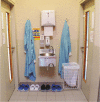Prevention of infectious diseases in cat shelters: ABCD guidelines
- PMID: 23813812
- PMCID: PMC11148948
- DOI: 10.1177/1098612X13489210
Prevention of infectious diseases in cat shelters: ABCD guidelines
Abstract
Overview: Recommendations are given in relation to infectious diseases in rescue shelters. The ABCD recognises that there is a wide variation in the design and management of shelters, and that these largely reflect local pressures. These guidelines are written with this diverse audience in mind; they point to the ideal, and also provide for some level of compromise where this ideal cannot immediately be attained. In addition consideration should be given to general requirements in order to optimise overall health and wellbeing of cats within the shelter. HOUSING: Compartmentalisation of the shelter into at least three individual sections (quarantine area for incoming cats, isolation facilities for sick or potentially infectious cats, and accommodation for clinically healthy, retrovirus-negative cats) can facilitate containment of a disease outbreak, should it occur. STANDARD OF CARE: Incoming cats should receive a full health check by a veterinary surgeon, should be dewormed and tested for retrovirus infections (feline leukaemia virus [FeLV] and/or feline immunodeficiency virus [FIV]) in regions with high prevalence and in shelters that allow contact between cats. Cats which are not rehomed should receive a regular veterinary check-up at intervals recommended by their veterinarian.
Vaccination: Each cat should be vaccinated as soon as possible against feline panleukopenia virus (FPV), feline herpesvirus (FHV-1) and feline calicivirus (FCV) infections. HYGIENE: Adequate hygiene conditions should ensure that contact between shedders of infectious agents and susceptible animals is reduced as efficiently as possible by movement control, hygiene procedures of care workers, barrier nursing, cleaning and disinfection. STRESS REDUCTION: Stress reduction is important for overall health and for minimising the risk of recrudescence and exacerbation of infectious diseases. In general, a special effort should be made to rehome cats as soon as possible.
Conflict of interest statement
The authors do not have any potential conflicts of interest to declare.
Figures



Comment in
-
Use of pheromones to reduce stress in sheltered cats.J Feline Med Surg. 2013 Sep;15(9):829-30. doi: 10.1177/1098612X13500882. J Feline Med Surg. 2013. PMID: 23966008 Free PMC article. No abstract available.
Similar articles
-
Molecular and serological investigation of cat viral infectious diseases in China from 2016 to 2019.Transbound Emerg Dis. 2020 Nov;67(6):2329-2335. doi: 10.1111/tbed.13667. Epub 2020 Jul 2. Transbound Emerg Dis. 2020. PMID: 32511839
-
[Parvovirus infections in cats in animal shelters].Tierarztl Prax Ausg K Kleintiere Heimtiere. 2023 Apr;51(2):107-115. doi: 10.1055/a-2065-8203. Epub 2023 May 25. Tierarztl Prax Ausg K Kleintiere Heimtiere. 2023. PMID: 37230115 German.
-
Prevalence of serum antibody titers against feline panleukopenia virus, feline herpesvirus 1, and feline calicivirus in cats entering a Florida animal shelter.J Am Vet Med Assoc. 2012 Nov 15;241(10):1320-5. doi: 10.2460/javma.241.10.1320. J Am Vet Med Assoc. 2012. PMID: 23113524
-
Common and emerging infectious diseases in the animal shelter.Vet Pathol. 2014 Mar;51(2):478-91. doi: 10.1177/0300985813511129. Epub 2013 Nov 21. Vet Pathol. 2014. PMID: 24265288 Review.
-
Feline herpesvirus infection. ABCD guidelines on prevention and management.J Feline Med Surg. 2009 Jul;11(7):547-55. doi: 10.1016/j.jfms.2009.05.003. J Feline Med Surg. 2009. PMID: 19481034 Free PMC article. Review.
Cited by
-
The Effect of Name and Narrative Voice in Online Adoption Profiles on the Length of Stay of Sheltered Cats in the UK.Animals (Basel). 2020 Dec 31;11(1):62. doi: 10.3390/ani11010062. Animals (Basel). 2020. PMID: 33396239 Free PMC article.
-
Feline Infectious Peritonitis: European Advisory Board on Cat Diseases Guidelines.Viruses. 2023 Aug 31;15(9):1847. doi: 10.3390/v15091847. Viruses. 2023. PMID: 37766254 Free PMC article. Review.
-
Feline Morbillivirus: Clinical Relevance of a Widespread Endemic Viral Infection of Cats.Viruses. 2023 Oct 13;15(10):2087. doi: 10.3390/v15102087. Viruses. 2023. PMID: 37896864 Free PMC article. Review.
-
Feline leukaemia virus infection: A practical approach to diagnosis.J Feline Med Surg. 2020 Sep;22(9):831-846. doi: 10.1177/1098612X20941785. J Feline Med Surg. 2020. PMID: 32845225 Free PMC article. Review.
-
Changes in Health Indicators of Welfare in Group-Housed Shelter Cats.Front Vet Sci. 2021 Sep 24;8:701346. doi: 10.3389/fvets.2021.701346. eCollection 2021. Front Vet Sci. 2021. PMID: 34631847 Free PMC article.
References
-
- McCobb EC, Patronek GJ, Marder A, Dinnage JD, Stone MS. Assessment of stress levels among cats in four animal shelters. J Am Vet Med Assoc 2005; 226: 548–555. - PubMed
-
- Group of Experts on dogs and cats. Working party for the preparation of the fourth multilateral consultation of parties to the European Convention for the Protection of Vertebrate Animals Used for Experimental and other Scientific Purposes (ETS 123). Species specific provisions for dogs, background information for the proposals presented, Part B. 6th meeting. Strasbourg, 25–27 March 2003.
-
- Geret CP, Riond B, Cattori V, Meli ML, Hofmann-Lehmann R, Lutz H. Housing and care of laboratory cats: from requirements to practice. Schweiz Arch Tierheilk 2011; 153: 157–164. - PubMed
MeSH terms
Grants and funding
LinkOut - more resources
Full Text Sources
Other Literature Sources
Medical
Research Materials
Miscellaneous

